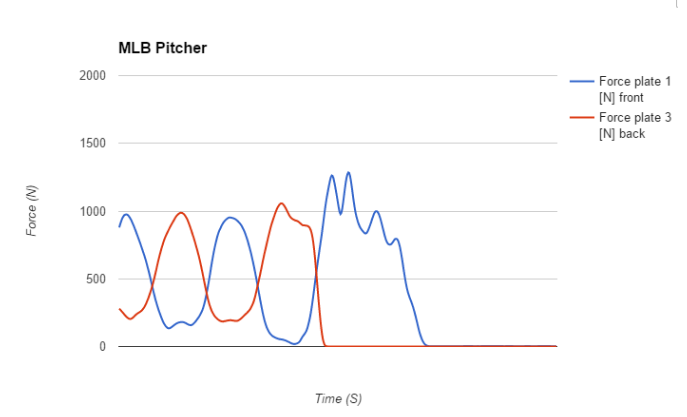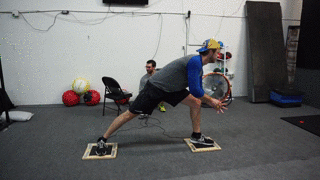Analyzing Front and Back Leg Ground Forces in Pitchers Using Force Plates

The lower half is consistently a hot topic amongst baseball coaches – stuck between focusing on getting a big push off the rubber or working on planting with your front leg. This article will go into peer-reviewed research as well as internal case studies performed on high level college and pro athletes.
Existing Research on the Lower Half
Research can be found that supports both sides of the lower half debate. Let’s take a look at some highlights.
Stride Leg Ground Reaction Forces Predict Velocity in Adult Recreational Baseball Pitchers
“Peak ground reaction forces imparted by the drive leg (back leg) were not significantly related to peak wrist velocity. Stride leg ground reaction forces in the vertical and posterior directions, we well as the resultant ground reaction force, were strongly correlated to peak wrist velocity during both the arm-cocking and arm-acceleration phases (r=0.68-0.79)”
Test Group: 18 former competitive baseball players with previous h/s or collegiate pitching experience.
Characteristic Ground-Reaction Forces in Baseball Pitching
“Linear wrist velocities at ball release correlate highly (r^2 = 0.82) with maximal posterior push-off shear force…Linear wrist velocity also correlated highly with vertical push-off force at MAP (r^2= 0.74), push-off resultant force at MAP (r^2=0.76), landing anterior shear force at BR (r^2=0.86), landing vertical force at BR (r^2=0.70), and landing resultant force at BR (r^2=0.88).”
Participants: 6 college and 1 high school pitcher
In short, the first study has the front leg as a predictor of velocity and the back leg negligent. The second found correlations between both back and front leg.
Study Design
We chose to examine front and back leg force production using our rocker drill and the Neulog force plates. From this we were able to collect peak compression force measurements or total force being put into the plate. (Neulog force plates do not measure anterior-posterior or lateral forces.)
We chose the rocker drill because we found pitcher’s often don’t land in the same spot during a wind up, making data collection difficult. Furthermore, the rocker drill lets the athlete set their front and back leg enabling us to collect better data. Because the bottom of the force plates tend to slip on the floor of our gym, we built a simple wood frame with Velcro on the bottom to lock them in place, which you can see in the above GIF.
For data collection we used the software that Neulog provided while writing down the the velocity of each throw. To get the best grasp of an athlete’s movement we had them execute 5 Rocker Drills with our yellow (150g ~ 5 oz) PlyoCare® ball.
The first piece of information we wanted to look at was peak forces and their relationship to velocity. Interestingly enough we found that all athletes ended up having multiple peaks on their front leg at/near release.
When examining the charts our best theory on why there ended up being two or more peaks on the front is because of a weight shift and push off force. The first peak the pitcher reaching his full weight shift, a small adjustment period, followed by a second peak when planting/pushing off the front leg. With any peaks following those two simply being the athlete adjusting to decelerating their motion. We ended up seeing a wide range of graphs when comparing our athletes.
Update 3/10/2017 after reviewing video of athletes using force plates in a more recent study, we believe that the two peaks come from how the athlete lands on the plate. The first peak is when the heel/toe hits the plate first, while the second peak is when the whole foot makes contact with the plate.
Data
When looking at the data of 15 athletes we ended up finding no correlation between either front or back leg and throwing velocity.
Correlation between Peak Forces and Throwing Velocity
| r^2 back leg to MPH correlation | 0.0451 |
| r^2 first front peak to MPH correlation | 0.0022 |
| r^2 second front peak to MPH correlation | 0.0061 |
*Because of the consistency of the two peaks we ran correlations between the first “weight shift” peak and second “force” peak
It’s important to note that these correlations are being run between the peak forces and velocity for each athlete. While it’s impressive to see athlete’s produce peak forces of up to four hundred pounds an athlete’s weight matters too. It’s much more impressive for an athlete weighing 220 lbs producing that amount of force versus an athlete weighing 280 lbs. So let’s run the numbers again only now factoring in bodyweight.
Correlation between Bodyweight Adjusted Peak Forces and Throwing Velocity
| r^2 back leg to MPH correlation | 0.0115 |
| r^2 first front peak to MPH correlation | 0.0096 |
| r^2 second front peak to MPH correlation | 0.0004 |
As always, we are releasing all of the raw data in this study; find it here if you are interested in seeing it and running your own analyses.
Again we see very little correlation between either front and back leg.
Study Discussion
Although the data is largely inconclusive on whether the front or back leg related more to velocity we can still take some valuable points from this.
- Moving Your Center of Mass Matters: In the Rocker Drill you shift your weight back and forth to throw but there is little movement of the center of mass. It remains relatively balanced between your front and back foot. You can see the weight shifts in the graphs but the center of mass is not moving very much. We’re not sure exactly how much it matters but with this data it makes sense. Moving your center of mass from the stretch to throwing front foot plant affects your force production.
- Fortunately, we have two great tools to help us analyze this – the BodiTrak mat that measures the rate of change in center of pressure, and the PUSH wearable band which plots x/y movement using an accelerometer/gyroscope IMU.
- Flat Ground vs Mound Work: If we link back to our idea of center of mass, it seems likely that being on a sloped mound will affect the the way that force is developed as well. Going down the mound is going to change the way that gravity affects the player thus affecting the force produced.
- The Direction of the Force Matters: The Neulog force plates are only able to measure total compression force. But if you take a closer look at the studies mentioned previously they were able to find correlations between specific vectors of force. I’ll repeat those parts below along with bolded sections.
Stride Leg Ground Reaction Forces Predict Velocity in Adult Recreational Baseball Pitchers
“Stride leg ground reaction forces in the vertical and posterior directions, we well as the resultant ground reaction force, were strongly correlated to peak wrist velocity during both the arm-cocking and arm-acceleration phases (r=0.68-0.79)”
Characteristic Ground-Reaction Forces in Baseball Pitching
“Linear wrist velocities at ball release correlate highly (r^2 = 0.82) with maximal posterior push-off shear force…Linear wrist velocity also correlated highly with vertical push-off force at MAP (r^2= 0.74), push-off resultant force at MAP (r^2=0.76), landing anterior shear force at BR (r^2=0.86), landing vertical force at BR (r^2=0.70), and landing resultant force at BR (r^2=0.88).”
This suggests that the way pitchers put force into the ground is an important factor for velocity. Looking deeper, both studies found correlations with force production in the vertical direction and resultant force of the front leg but differed when looking at the relationships in the posterior and anterior direction. While with the back leg the second study found a correlation between the posterior push-off force.
We were able to replicate this study using triaxial force plates and we found different results.
Final Thoughts
Reading peer reviewed research is a big part of what we do at Driveline, but if we don’t try to replicate or validate the results then we are failing.
“If you don’t experimentally validate research you picked out of a textbook or published paper, that’s not science. That’s faith.”
This article is a perfect example of why. If you read enough research you are bound to come upon papers that contradict each other. Whether because of sample sizes or measurement tools, it really doesn’t matter. Because reading the research is the first step. The second step is doing whatever we can to take those results and figure out a way to test them and make them improve our program. This is why after coming upon the research presented above it became clear that we must find a way to test our own athletes and see what occurred.
In the end the results that we saw do help us. They help us create better questions and experiments to test to improve our process.
The majority of this article was written by Michael O’Connell, who is our first analyst in the Research and Development department of Driveline Baseball. He also collected all of the data and designed the study. This article was edited and approved by Kyle Boddy, President/Founder of Driveline Baseball.
Comment section
Add a Comment
You must be logged in to post a comment.

Analyzing Lower Half Pitching Mechanics Using Force Plates - Driveline Baseball -
[…] initially inspired our research, and so we conducted our own study to find out what was really up. Using two synced uni-axial (one direction) force plates, we had our athletes perform a rocker throw, and were unable to find any meaningful correlation between force production and ball […]